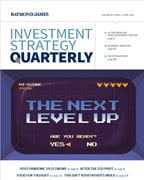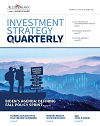After the Fed pivot: Where are the opportunities?
- 04.10.24
- Markets & Investing
- Article
Senior Investment Strategist Tracey Manzi notes that with a Federal Reserve easing cycle on the horizon, the fixed income markets are relatively attractive.
To read the full article, see the Investment Strategy Quarterly publication linked below.
The Federal Reserve’s (Fed) pivot late last year sparked an enormous rally in the bond market. In fact, U.S. Treasurys and nearly all fixed income sectors enjoyed some of their best quarterly returns on record. The sharp decline in yields over the final quarter of 2023 was a textbook reaction as market participants are well versed in what typically comes after the Fed pivots – softer growth, lower inflation and the commencement of an easing cycle. While the timing of the Fed’s easing cycle after the final rate hike varies, historically the Fed’s first rate cut has come an average of seven months after the last rate hike, based on the last six cycles.
With the Fed delivering its final rate hike in July 2023, we are now approaching the window – which has ranged from one to 14 months – where policymakers have typically kicked off their easing cycle. While notable, this cycle has been anything but average. Case in point: after 550 basis points of tightening (one of the most aggressive cycles in history), the economy continues to show surprising resilience – strong job growth, slowing, but still above-trend growth and record low unemployment. Why? The government’s ongoing fiscal expansion, where the budget deficit is now running at ~6% of GDP. While the fiscal stimulus may have lengthened the economy’s runway, our economist expects growth and inflation to slow over a six-to-12-month horizon. This expected cyclical slowdown should keep the bond market focused on the timing and pace of the Fed’s eventual rate cuts.
Starting yields are the strongest predictor of future returns
Given the ongoing strength in the labor market and still solid economic growth, the Fed can afford to exercise patience. In fact, the resilient economy has been a major factor behind why excessive rate cuts this year have been largely unwound and a key reason why Treasury yields have moved modestly higher since the start of the year. With the market now pricing in three rate cuts by year end, Treasury yields will be swayed (up or down) by the incoming data. But with the Fed telling us that interest rates have peaked for the cycle and that rate cuts are on the horizon as long as the disinflationary trend remains intact, Treasury yields will eventually be headed lower – albeit likely at a slower pace than we originally anticipated.
While our call for moderately lower yields in 2024 may be delayed as long as economic growth remains solid, we still believe the current high level of yields remains an attractive opportunity for investors. That's because the starting level of yields is the single best predictor of a bond’s total return over longer periods of time.
Where we see opportunities
Treasury yields are likely to trade in a wide range again this year given the economy is at an inflection point. In the near term, we see scope for Treasury yields to move in either direction. For example, any weaker than expected economic news (whether on the growth, jobs or inflation front) could drive yields significantly lower as the market reprices to a more aggressive Fed easing cycle—with a move to 3.5% not out of the question. Conversely, any signs of waning demand at the upcoming Treasury auctions (2024 will be another year of heavy Treasury issuance to fund the deficit) could easily push yields higher to 4.5% again. These trading ranges should create some opportunities for investors along the way. But by year end, we believe yields should be within the ballpark of where they started the year. However, with the economy still on solid footing, we are modestly raising our 10-year Treasury yield forecast to 3.75%.
Conclusion
With a Fed easing cycle on the horizon, the fixed income markets are relatively attractive. Today’s yields remain near their highest levels in well over a decade, providing investors with an opportunity to lock in the current levels of yield. Capital appreciation opportunities may come, particularly if economic growth turns out to be weaker than expected. But even without the bonus of capital appreciation, the more normal level of yields suggests investors can now earn a reasonable return on their bond investment. And that return should be much higher going forward than what an investor could earn in the prior decade. Relative value opportunities exist within the fixed income sectors for those looking to augment their core fixed income exposure.

Read the full
Investment Strategy Quarterly
All expressions of opinion reflect the judgment of the Chief Investment Office, and are subject to change. This information should not be construed as a recommendation. The foregoing content is subject to change at any time without notice. Content provided herein is for informational purposes only. There is no guarantee that these statements, opinions or forecasts provided herein will prove to be correct. Past performance may not be indicative of future results. Asset allocation and diversification do not guarantee a profit nor protect against loss. The S&P 500 is an unmanaged index of 500 widely held stocks that is generally considered representative of the U.S. stock market. Keep in mind that individuals cannot invest directly in any index, and index performance does not include transaction costs or other fees, which will affect actual investment performance. Individual investor’s results will vary. Investing in small cap stocks generally involves greater risks, and therefore, may not be appropriate for every investor. International investing involves special risks, including currency fluctuations, differing financial accounting standards, and possible political and economic volatility. Investing in emerging markets can be riskier than investing in well-established foreign markets. Investing in the energy sector involves special risks, including the potential adverse effects of state and federal regulation and may not be suitable for all investors. There is an inverse relationship between interest rate movements and fixed income prices. Generally, when interest rates rise, fixed income prices fall and when interest rates fall, fixed income prices rise. If bonds are sold prior to maturity, the proceeds may be more or less than original cost. A credit rating of a security is not a recommendation to buy, sell or hold securities and may be subject to review, revisions, suspension, reduction or withdrawal at any time by the assigning rating agency. Investing in REITs can be subject to declines in the value of real estate. Economic conditions, property taxes, tax laws and interest rates all present potential risks to real estate investments. The companies engaged in business related to a specific sector are subject to fierce competition and their products and services may be subject to rapid obsolescence.



